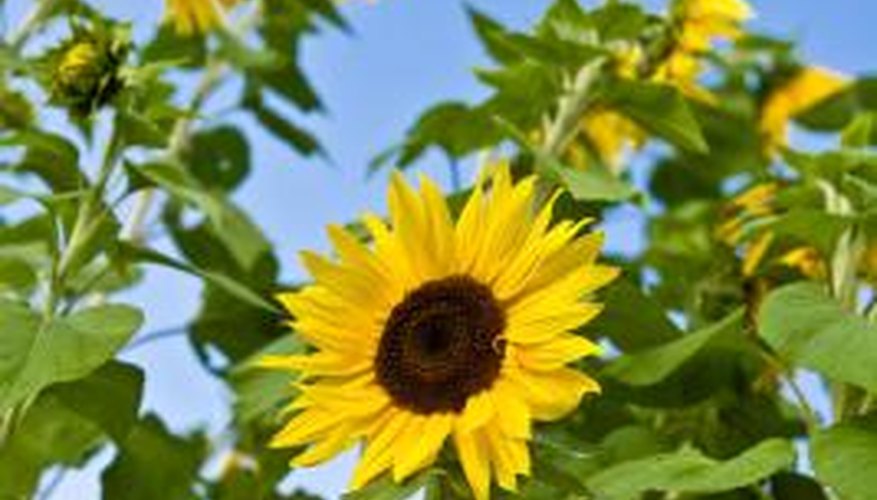The sunflower, with its tall stalks and distinctive yellow and black bloom, is a drought-tolerant plant with a short summer growing season. The beauty of the sunflower is appealing not only to people but insect pests that eat foliage, roots and flower of the plant. Cultural control and applying chemicals can keep your sunflowers from being eaten.
Beetles and weevils
Beetles and weevils are among the insects that primarily feed on the roots and stems of the sunflower plant. The carrot and longhorned beetles deposit eggs on or near the sunflower plant; the larva hatch during the growing season and sustain themselves by eating the lower parts of the plant. The flea beetle also eats sunflower plants, but feeds on the leaves and seedlings of the plant. Wilting and irregular holes on the sunflower leaves can indicate a beetle infestation. Weevils vary in size and colour, deposit eggs in the walk of the plant and feed on the stems and leaf tissues of the sunflowers. Weakening of the plant and root structure can be a sign of weevil presence. Tilling the soil well to eliminate larva that has not yet damaged the sunflowers can be a non-toxic control method. Chlorpyrifos-based pesticides may also be needed, depending on the level of infestation.
- Beetles and weevils are among the insects that primarily feed on the roots and stems of the sunflower plant.
- The carrot and longhorned beetles deposit eggs on or near the sunflower plant; the larva hatch during the growing season and sustain themselves by eating the lower parts of the plant.
Moths
Moths eat sunflower plants as well as beetles and weevils. The sunflower moth feeds on the head and seedlings of the plant, while the sunflower bud moth damages the stem and unopened buds of the plant. Moths leave a sticky, webbed reside on the plant as well as holes that indicate its feeding path. Larvae that feed on sunflowers can lead to stems that are misshapen, and the stunted development of the head of the flower. Natural trapping using pheromones can control the sunflower and sunflower bud moth population. Insecticides containing the chemical phytomelanin may also be considered for management.
- Moths eat sunflower plants as well as beetles and weevils.
- Natural trapping using pheromones can control the sunflower and sunflower bud moth population.
Crawlers
Sunflowers can provide an ample meal for a number of wiggling, crawling pests, including maggots, caterpillars and army worms. Painted ladies and woollybear caterpillars can render significant defoliation of the sunflower plant as they munch their way through the leaves and flowers of the plants. Green army worms and cutworms are also major offenders of sunflowers and leave ragged holes or "windows" in the leaves. Windows are transparent areas on the leaf that occur when the larvae or young stages of the creatures begin to feed on the sunflower but are not big enough to poke a hole through the entire leaf. The threat of defoliation to at least 1/4 of the plant's surface or the entire crop usually warrants using a chemical control against crawling pests.
- Sunflowers can provide an ample meal for a number of wiggling, crawling pests, including maggots, caterpillars and army worms.
- Painted ladies and woollybear caterpillars can render significant defoliation of the sunflower plant as they munch their way through the leaves and flowers of the plants.
Grasshoppers
Grasshoppers eat sunflower plants but generally do not cause as much damage as other insect pests. Grasshoppers can be hand picked off of the plants when the population is small. Larger infestations may require chemical controls to prevent the young nymphs from migrating to neighbouring fields or gardens. Beta-cyfluthrin and acephate are two non-restricted chemical controls that you can use in non-crop areas to manage grasshoppers on sunflower plants.
- Grasshoppers eat sunflower plants but generally do not cause as much damage as other insect pests.
- Larger infestations may require chemical controls to prevent the young nymphs from migrating to neighbouring fields or gardens.
